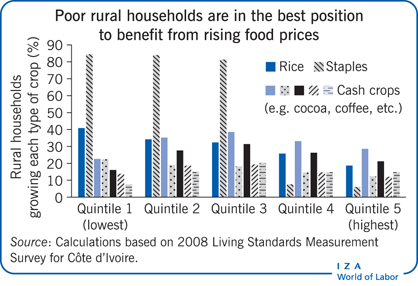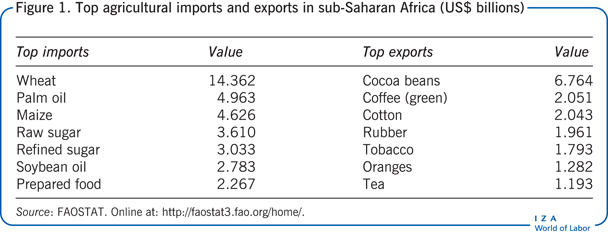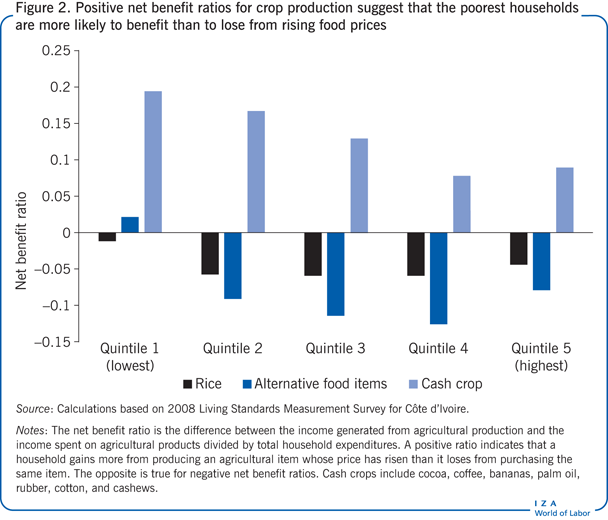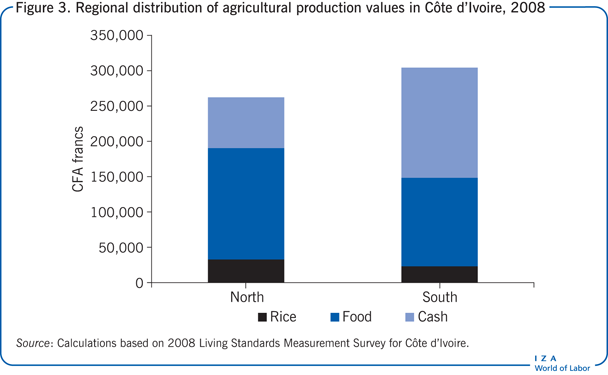Elevator pitch
Dramatic food price spikes in recent years have stimulated debate on the welfare implications of food price risk. According to the Food and Agriculture Organization of the United Nations, the number of undernourished people in sub-Saharan Africa rose to a record 265 million in 2009. There is a gradually developing policy consensus in favor of income redistribution to the poor in developing countries hit by the food price crisis. This recommendation makes sense when the poor are net food consumers, but it ignores the possibility that some poor people are net producers of food and so are likely to benefit from rising food prices.

Key findings
Pros
Rising food prices are likely to alleviate poverty and inequality in areas where poor people are net food producers (produce more food than they consume).
Rising food prices are likely to be welfare-enhancing in areas where women are farmers, because female spending patterns tend to be more child-friendly.
When rising food prices stimulate food production, they may generate new jobs (and related income) that can improve welfare.
The urban middle class relies on non-agricultural employment for its livelihood and so is likely to be more affected by rising food prices than the poorest population segments.
Cons
Rising food prices can exacerbate poverty and inequality when the poor are net food consumers (consume more food than they produce) and there are few non-farm jobs.
The welfare implications of rising food prices are ambiguous—even if women are farmers—if complementary resources for crop commercialization are scarce.
Analyses often disregard the possibility of behavioral changes in response to price shocks, e.g. substituting less expensive foods for more expensive ones.
Rising food prices can exacerbate poverty in the long term when domestic institutional constraints, the international agricultural trade environment, and weather and climate conditions constrain the use of modern high-yielding farming techniques.
Author's main message
Properly assessing the impact of rising food prices on poverty and inequality in developing countries, where economies are largely agriculture-based, requires analyzing the links between the agricultural output market and the labor market. Rising food prices may boost welfare in contexts where the poor (especially women) are among the largest net food producers and may generate new employment where rising prices stimulate expanded food production. Because urban residents are the most affected by rising food prices, creating productive job opportunities in urban areas should be a policy priority.
Motivation
Heated academic and policy debate on the welfare implications of food price risk broke out following an approximate 50% rise in global food prices between April 2007 and March 2008, with a similar increase a few years later. Early research (typically simulations based on cross-country data) predicted severe negative welfare implications of rising food prices among the poorest population groups in food-importing developing countries. Other research warned against oversimplification and underlined the need to explore the complex implications of food price spikes for both the supply and demand side of the market, taking individual country circumstances into account [1].
Later, more careful analyses have tried to reconcile divergent views by compiling both cross-country and case study analyses and deriving some generalizable messages. The dominant macro-level message is that, while net food-exporting countries are likely to gain from the commodity price boom, poor countries—especially those relying on food imports and cash crop exports—are likely to be negatively affected. Most of the policy focus is on sub-Saharan Africa, in response to estimates that rising prices had pushed an additional 24 million people into hunger, increasing the number of undernourished to a record 265 million in 2009 [2]. This estimate is not surprising, given the role of agricultural specialization in these economies. Specifically, while the structure of African economies differs from country to country, on average the continent is dependent on food imports and tends to have a comparative advantage in (traditional) tropical cash crops, many of which are losing their competitive edge in international markets (Figure 1).

While the results of macro-level analyses of the effect of rising food prices are fairly straightforward, the micro-level research highlights much more mixed and context-specific evidence. There is a gradually developing consensus in favor of measures to improve incentives for farmers to increase food supply, together with measures leading to more progressive income redistribution [3]. This policy advice is sometimes difficult to reconcile with failed past attempts to ensure food self-sufficiency in poor economies affected by a food price spike. Detailed accounts document the failures of food-importing countries in Africa (and elsewhere) to respond successfully to previous food price spikes by boosting food production [4], [5]. For example, the food price shock of the 1970s prompted the government of Côte d’Ivoire to support food self-sufficiency by heavily subsidizing local rice producers. The program ended in bankruptcy because of the inability to reconcile producer support with low consumer prices and a lack of fiscal resources.
There is also evidence that income redistribution may not be the answer either. Indeed, there is both theoretical and empirical support for the argument that the income redistribution effect of a price shock depends on country-specific characteristics of national food and labor markets. The research summarized below attempts to unbundle these complexities, throw some further light on the multifaceted implications of food price risk, and highlight some gaps in existing academic and policy research that constrain our understanding of the phenomenon.
Discussion of pros and cons
Conceptual framework
Because households are both consumers and producers of food, the natural, micro-level starting point for analyzing the welfare implications of changing food prices is a model explaining how households make consumption and production decisions about food and other agricultural crops. The simplest empirical approach is to calculate the net benefit ratio from the production and consumption of a range of agricultural commodities. The net benefit ratio represents the difference between the income generated from agricultural production and the income spent on agricultural products divided by the household’s total expenditures. A positive net benefit ratio indicates that a household gains more from producing an agricultural item whose price has increased than it loses from purchasing the same item that has now become more expensive. The opposite is true for a negative net benefit ratio. The signs (positive or negative) of the net benefit ratios faced by households in different income quintiles thus give a sense of whether poorer households gain or lose more than richer households when food prices rise.
To illustrate this point, Figure 2 presents the net benefit ratios for Côte d’Ivoire, a cash-crop-exporting and food-crop-importing country [6]. It shows net benefit ratios for rice, the main staple food in Côte d’Ivoire, alternative food items, and tropical cash crops (including cocoa, coffee, bananas, palm oil, rubber, cotton, and cashews) for households in different income quintiles in 2008, the year of a large increase in food prices. The poorest households (quintile 1) are characterized by positive average net benefit ratios, suggesting that the poorest (generally self-subsistent) households are more likely to benefit than to lose as a result of rising food prices. The opposite is true for households in the higher income quintiles, which experience most of the negative impact of the price shock. At the same time, because poorer households are generally more likely than richer households to produce cash crops as well as food crops, the net benefit ratios from the production and consumption of tropical cash crops fall as income rises. In other words, in the specific context of Côte d’Ivoire, there is a redistribution of income from richer to poorer households in a period of rising food prices.

This method of assessing the welfare implications of rising food prices is particularly appealing in traditional contexts, such as in much of sub-Saharan Africa, where the rural landscape is dominated by small farmers (smallholders), producing either food or cash crops or both by relying mainly on family members and hiring only very limited amounts of labor. In such contexts, it may be sufficient to verify whether smallholders are net producers or net consumers of food and observe how the net income generated (or lost) from crop production plus the costs of consumption affects welfare for different segments of the income distribution. However, this baseline model has its limitations in an environment where most agricultural workers are on wage contracts rather than being family farmers or sharecroppers. In that kind of environment, ignoring the effect of a price shock on labor demand and supply and thereafter on agricultural wages is likely to produce a biased estimate of the welfare implications of the price shock. Recent research, especially in contexts like Brazil and India, where hired labor is common, takes this secondary labor market effect of a price shock into account.
Occupational choices and the implications of price shocks for net food buyers and sellers
Several questions need to be answered to properly assess the welfare implications of a food price spike:
What are the occupational opportunities in a country or region affected by a food price shock?
Who are the food producers?
Are poorer or richer households more likely to be affected?
Research that addresses these questions reaches nuanced, sometimes counterintuitive, conclusions. For instance, much of the policy analysis of net food-importing African countries tends to assume that net buyers of food by far outnumber net sellers of food, even in rural areas and especially among the poor. The implication is that rising food prices will result in a regressive redistribution of income across countries and across individuals both within and between countries.
More detailed analyses acknowledge that simply counting the number of net food buyers across the income distribution is inadequate. It is also essential to consider whether they are just marginal food buyers and to assess what occupational choices they can rely on to smooth their consumption and income. For example, an analysis of the welfare implications of rising food prices across nine poor developing countries concludes that although the largest share of poor households can be identified as net food buyers, almost half of them are just marginal net food buyers who are not significantly affected by food price increases. Furthermore, the average incomes of net food buyers are higher than those of net food sellers in eight of the nine countries examined [1].
Furthermore, as observed in Figure 2, rising food prices led to the redistribution of income from richer to poorer households in Côte d’Ivoire. While Figure 2 illustrates the average redistribution of income for the country as a whole, the regional production pattern illustrated in Figure 3 indicates that the redistribution of income from richer to poorer households also takes place across geographic regions. Specifically, households in the poorer northern part of the country are more likely to produce food than households in the richer southern part of the country, suggesting that rising food prices are more likely to favorably affect households in poorer geographic areas.

Unlike the progressive income redistribution findings of cross-country-based macro-level studies of the net benefits and net costs of being a food importer or exporter of food, research on large food-exporting countries like Brazil and India identifies a regressive redistributive effect of rising food prices. In Brazil, where 80% of the population resides in urban areas, poverty is an urban phenomenon, and agricultural production relies on wage contracting rather than small farmer-operated smallholdings, rising food prices are found to increase extreme poverty by 11–12.3%. The impact on inequality is more complex, however. Low-income groups are affected less than middle-income groups, while high-income groups are barely affected because they spend a much smaller proportion of their income on food [7]. As in the case of Côte d’Ivoire, the brunt of the food crisis appears to be borne by middle-income urban dwellers.
In India, where land distribution is highly unequal, better-off large farmers gain from rising food prices, while poor rural households lose from the price rise—and the size of the average gain among better-off farmers is quite large. In fact, evidence from India argues against the conventional wisdom that the main group that needs to be sheltered from rising food prices is the urban poor. The main category of poor households negatively affected by the rise in prices in India reside in rural areas. These households constitute 77% of all poor households that lose as a result of rising food prices, and they include both farmers and non-farmers [8].
Although results on the direction of the redistributive effect of rising food prices differ, urban residents and non-food-producing rural residents are by default bound to lose more as a result of rising food prices than food-producing rural residents. Assessments of the welfare implications of rising food prices should therefore focus on exploring the structure of non-agricultural employment opportunities. A large number of studies on sub-Saharan African countries suggest that self-employment represents a substantial proportion of these job opportunities. It is therefore important to study the nature of both self-employment and alternatives to self-employment. Government effort should focus on expanding productivity- and welfare-enhancing opportunities across rural and urban labor markets.
Limitations and gaps
Further research questions and limitations
Analyses of the gains and losses from rising food prices such as those discussed here, in particular those that account for the transmission of the food price shock to welfare through changes in wages in the agricultural labor market, provide a fairly balanced view of the immediate welfare impacts of rising food prices. A large enough number of such rigorous analyses have now been conducted across a range of institutional settings, making it possible to reach some generalizable conclusions. A major shortcoming of these analyses, however, is that they disregard the possibility of behavioral changes in response to a food price shock, such as substituting less expensive foods for more expensive ones on the consumption side and either making different crop production decisions or switching jobs on the producer and labor market side. Either of these could have important direct and indirect (through the labor market) implications for household welfare.
Consider the example of Côte d’Ivoire again. The country is self-sufficient in the production of local food varieties, such as local rice, cassava, and plantains, but it is heavily dependent on imported rice, which is of higher quality than locally produced rice and is needed to meet the increasing demand for rice in the country. If demand for imported rice is relatively price-elastic and there are few production constraints, rising international prices may induce a shift in consumption from imported to local food and subsequently a shift in the production of local food varieties, thus enhancing the welfare of their producers. While a few consumption-based analyses have considered the impact of price spikes on consumption substitutions, the literature is rather inconclusive. For instance, some recent studies have contradicted the findings of research on the food price shock of the mid-1990s across several west African economies, which had concluded that the elasticity of demand for imported rice is fairly low. That means that the rising international price of rice would have induced losses among net buyers that were larger than the gains among relatively poorer net food producers.
Perhaps even more important, analyses of behavioral changes on the consumption side of the equation tend to be conducted separately from analyses of the production side, and there has been little research on reactions to relative crop price changes on the producer side of the market. The scarcity of such studies may reflect the scarcity of panel data for developing countries, which are needed to capture both immediate production reactions to temporary price shocks and longer term reactions to changing relative price trends. As a result, much of the research on production choices and their livelihood and welfare implications are based on restrictive time frameworks and contexts and so reach limited, time-specific conclusions.
For instance, studies that have explored the allocation of production into tropical cash crops during times of tropical export booms have found such reallocation to be welfare enhancing [9]. By contrast, studies investigating cash crop production during periods of fluctuating commodity prices have found such production to be welfare reducing [10]. However, the debate on whether tropical cash crops compete with food crops and lead to food crises or whether there is complementarity between the two, with food production benefiting from the promotion of tropical export crops, has not yet been conclusively resolved. Analyzing this question using panel data for a long enough period and in the same geographic context would be a good starting point in trying to resolve this debate.
The special case of gender
One of the most high-profile areas of research on development today focuses on the determinants of women’s occupational choices and how those choices affect female empowerment and the welfare of the next generation. In traditional agricultural societies, an underlying premise of this line of research is that specific crops are labelled as either men’s crops or women’s crops. Typically, traditional cash crops are considered men’s crops, while food crops are considered women’s crops. Furthermore, men and women in a number of African contexts hold separate income accounts and spend their incomes on different household goods. There is some evidence that women spend more of their income on food and child-related expenses such as schooling. Positive price spikes for women’s crops are thus observed to enhance child welfare [11].
Following this logic, rising food prices (or, for that matter, any event that enhances the productivity and income-generation potential of women’s crops) are expected to have a positive impact on female empowerment and thereafter on welfare. However, this ad hoc demarcation of production based on gender has been shown to be blurry in practice, and policy experiments based on such assumptions have resulted in perverse behavioral responses. In Gambia, for instance, where women used to be traditional rice growers, it was assumed that the introduction of better technology for rice in the form of pump irrigation would improve household welfare through its productivity-enhancing effect on women. However, because women faced severe constraints in access to credit and hired labor, they failed to adopt the new technology and continued to farm rice using traditional practices. Meanwhile, men began to move into irrigated rice production, which led to an increase in annual per capita income and food consumption [12]. Thus, in a dynamic setting and in a context of institutional constraints to female empowerment that blocked women’s access to complementary resources, it is plausible to assume that men are more likely than women to adopt the types of crops that become more profitable. The welfare implications of such behavioral changes at the household level are unclear and would need to be taken into account both in general and when assessing narrower gender issues related to the effect of price or other shocks to agriculture.
Summary and policy advice
Studies on the impact of rising food prices on labor and through labor on welfare have reached different conclusions. The findings depend on a diverse set of institutional determinants of food production and of alternative agricultural production. They also depend on the occupational choices available in a country that is affected by an agricultural price shock and the complex interactions between labor and product markets. In contexts where the agricultural sector is dominated by small farmers, some of whom are able to smooth their consumption by moving into or expanding commercial crop production or by finding other means to supplement agricultural income, the effect of rising food prices on poverty and inequality tends to be subdued. By contrast, in contexts where there are many net-food-buying urban poor, land distribution is skewed toward the better-off, and there is a high incidence of landless rural poor, rising food prices tend to be associated with rising poverty and inequality. In these contexts, increased demand for agricultural labor to meet rising food demand can smooth some of the impact of the food price shock on net food-demanding hired laborers, but the effect is not large enough to significantly alter the negative consequences of the food price spike.
Despite this heterogeneity of observed outcomes, there is a gradually developing consensus in favor of encouraging the uptake of higher-yielding green revolution farming practices and implementing progressive income redistribution policies as a general reaction to the food price crisis. While such policy recommendations are difficult to dispute on conceptual grounds and can be justified by the evidence, they may not be very realistic—or effective. Analyses have revealed numerous barriers to the successful uptake of green revolution technologies, and there are detailed historical accounts of the failure of food-importing countries, especially in Africa, to respond successfully to previous food price spikes by boosting food production [4]. Most analyses focus on the institutional constraints to implementation of green revolution farming practices within individual countries while disregarding the role of international trade constraints and environmental change. Academic debate and policy advice related to rising food prices need to adopt a more holistic, inter-disciplinary approach that takes all these factors into account.
Furthermore, to be effective in a developing country environment where income inequality is high, an income redistribution policy requires the reallocation of a large portion of resources from the small, better-off share of the population to the much larger and much worse off share of the population [2]. However, it has proved to be difficult to effectively tax those at the higher end of the income distribution. Thus to ensure adequate resources to finance such policy measures, a workable policy probably requires also taxing the middle class. That brings up problems related to economic efficiency and fairness, as it would involve taxing people in the middle of the income distribution, who are relatively more deprived than those at the top of the distribution [2]. Indeed, the urban middle class is likely to be more affected by rising food prices than either the poorest or the richest population segment. This has been demonstrated in the studies reviewed here on rising food prices across both largely agriculture-based, food-importing, small farmer-dominated economies and net-food-exporting, highly urbanized, mainly hired-agricultural-labor-based economies.
The urban middle class relies almost exclusively on non-agricultural employment for its livelihood, and therefore a policy priority should be to create productive, non-agricultural labor opportunities in response to both food price shocks and other economic shocks. Moving up the value chain in agriculture and exploring modern industrialization choices should be high on the policy agenda. So should further efforts to increase agricultural yields by introducing green revolution technologies that are consistent with their geographic and environmental context. Well-developed infrastructure and a conducive institutional environment, as well as well functioning capital markets, are also needed to support these growth- and welfare-enhancing policy priorities.
Acknowledgments
The author thanks an anonymous referee and the IZA World of Labor editors for many helpful suggestions on earlier drafts.
Competing interests
The IZA World of Labor project is committed to the IZA Guiding Principles of Research Integrity. The author declares to have observed these principles.
© Ralitza Dimova